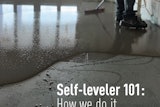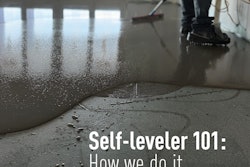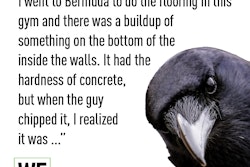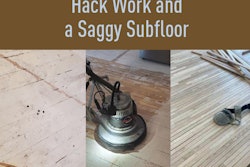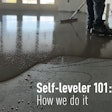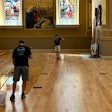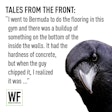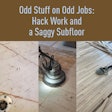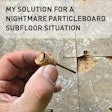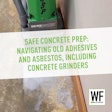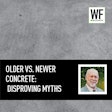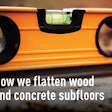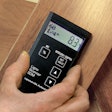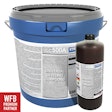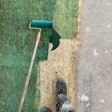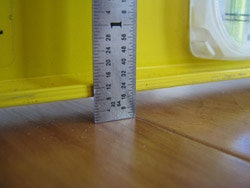
We only ask four things of a subfloor. It must be clean, dry, sound and flat. That's all. Remember, your subfloor is the foundation of your finished wood floor. If you're not building on a sure foundation, your work is going to fail. When it does, believe me, there will be weeping and gnashing of teeth. So, let's review these terms one more time.
Clean
This is important in a nail-down installation, but heart-stoppingly critical in a glue-down. The adhesive needs to sink its little fingers into the concrete or plywood in order to hold on for the life of the floor. Anything that prevents that is a problem. So paint, wax, sealer, finish, drywall dust, joint compound, spilled kerosene from the space heater, etc., will have to be removed. You need to wash, scrape, sand, grind, or shotblast, if necessary, to eliminate these problems.
Curing compounds in the mix and power trowel finishing of concrete slabs fall into this category, as well. Both of these close up the pores on the surface of the concrete, preventing the adhesive from bonding. Drip a few drops of water on the clean concrete. If the water beads up and doesn't soak in after a few seconds, your adhesive won't soak in, either. Scarify the surface, clean up the dust, and then start spreading adhesive.
One more thing while we are on this topic: If you're one of those guys who says, "I'll just pick up the dust with my trowel as I spread the adhesive," you're not asking for trouble—you're begging for it.
Dry
I assume you all know why the subfloor has to be dry. You are in the wood flooring business, after all. But for those of you new to this, moisture is kryptonite to your superman wood floor. Moisture movement into or out of the finished floor creates a host of problems. So the goal is to install the wood flooring on a subfloor of similar moisture content. The only way to do this is to test.
Every wood installer should own two moisture meters: an invasive (or pin) meter and a non-invasive meter. One tests wood and the other tests concrete; they are not interchangeable. Don't go sticking the pins of an invasive meter against a concrete slab and say you did a moisture test. The readings you get are wrong. And make sure you do the moisture test recommended by the wood flooring manufacturer (which may be calcium chloride or something else).
Test the subfloor and the wood flooring before and after acclimation. Write down the results and keep them in the job file. Pictures of the meter are even better. You will save yourself thousands of dollars if it is ever called into question. Don't just take one test and call it good. Take lots: every 50 to 100 square feet. A meter only takes a few seconds and you may discover patterns of moisture intrusion (from exterior walls, sliding glass door tracks, etc.).
A final word about moisture and concrete slabs: Concrete is a rigid sponge. Moisture travels through concrete at will. Plastic vapor barriers under on-grade slabs do not prevent moisture intrusion. Moisture content in the soil varies wildly over time. For this reason, it is a good practice to apply an approved moisture barrier on every concrete slab on grade. If the moisture content is fine now, sell it to the end user as protection from future moisture problems.
Sound
In Florida, where I live, approximately 90 percent of the floors are installed over a concrete slab (suspended or on-grade). So soundness is generally not an issue. If you have vertical deflection in a concrete slab, you have bigger problems than just your floor. On wood subfloors, always check thickness and joist spacing. Don't rely on what the owner or GC tell you it is. If it doesn't comply with NWFA Installation Guidelines (Sec. II, Chapter 4), then stop the job until somebody makes some changes. Nobody likes a wooden trampoline.
Flat
This is the second-biggest source of problems after moisture. Too many installers glance at a subfloor from a standing position and say, "That looks flat enough. I'll use some extra adhesive in the dips." This always fails because they never end up using extra adhesive, and because adhesive stinks as a leveler. I knew a dealer who did a lot of new construction work. He would brag to me that his guys never leveled the subfloors before installing and there was never a problem. A few seconds later he also told me he bought wood floor squeak injection kits by the truckload.
An insufficiently smooth subfloor creates more problems than just hollow spots and that lovely popping sound the homeowner is so fond of. It will create gaps, cracks, overwood, creaking, worn and broken joints in floating floors, cracked cores and both vertical and horizontal movement.
Always, always, always check for flatness. Pull a string, drop a straight edge, shine a laser, do whatever you have to do, but check it. It may not be your job to fix a subfloor at your own expense, but it is your job to check it.









